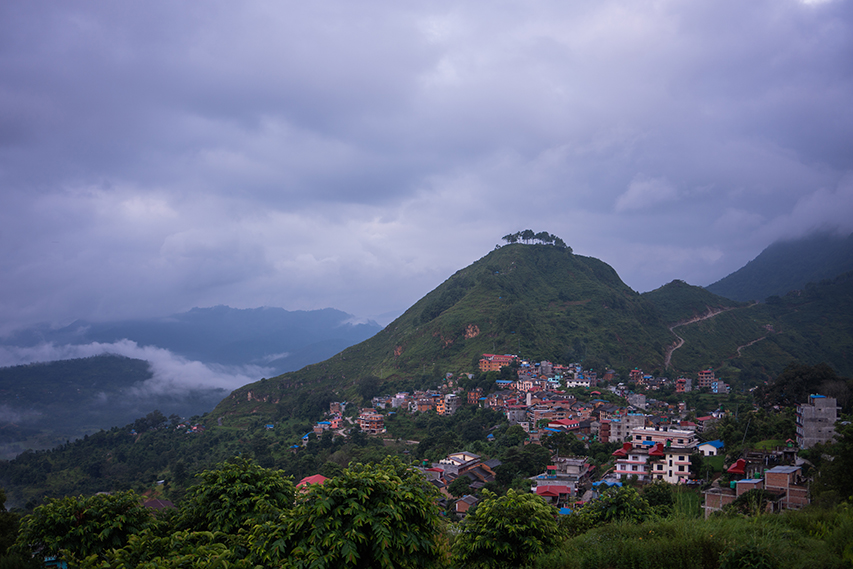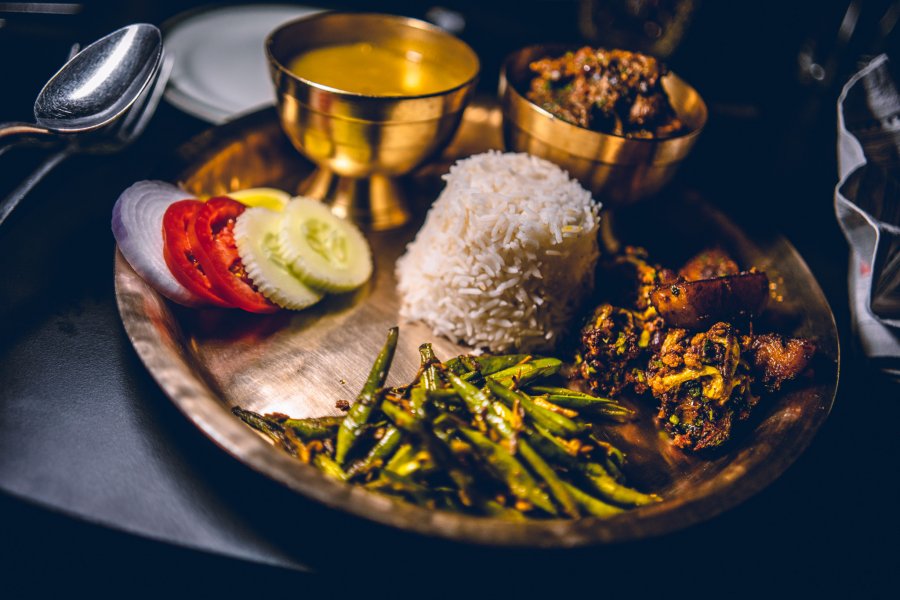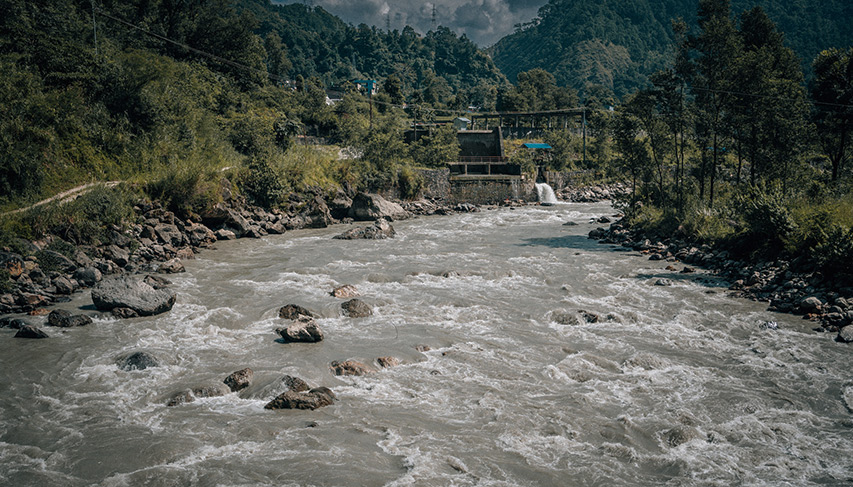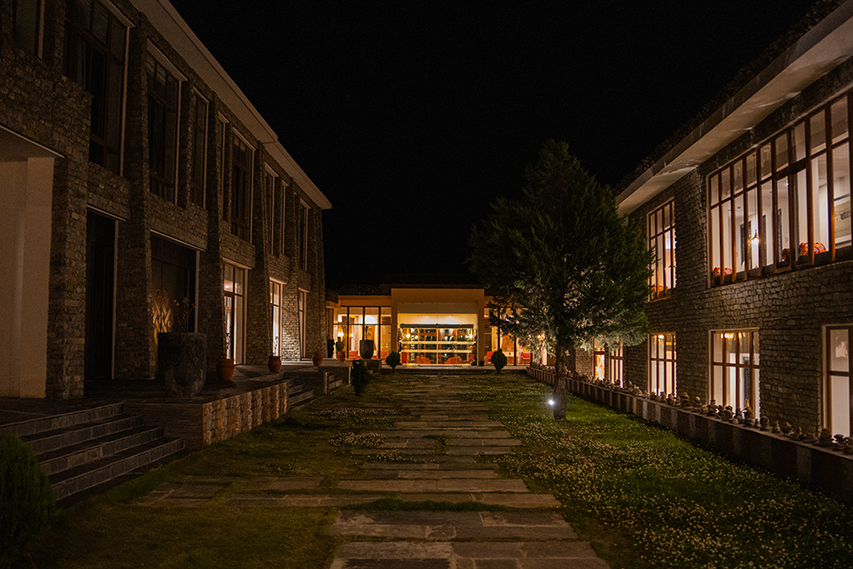Direct flights to Nepal for Bangkokians are back. You can be in Kathmandu in 3.5 hours with Thai Smile Airways. From there it’s rhinos in Chitwan, Everest if you’ve got the dosh, or you can just walk around and make the “Mo’ momos, Mo’ problems” joke as much as you want.
But, there is another reason to be in Nepal these days: Shinta Mani Mustang.
Star-chitect and designer Bill Bensley—known for his eccentric, infectious personality as much for his world class design—is something of a local celebrity in his adopted Bangkok home. Even his studio at Sukhumvit Soi 61 is something of a landmark.
Last month, Bill Bensley opened up Shinta Mani Mustang, taking his Southeast Asia brand and bright bohemian style to Nepal. Now, every travel journalist, TikTok star, and influencer is trying to find their way to Mustang to show off Nepal’s hottest hotel opening.
Getting to Jomsom, home to Shinta Mani Mustang, however, isn’t so easy. It’s two flights, a helicopter, or an 18-hour bus ride. There is, however, a more fun—and much, much more insane—way to get there: by motorcycle.
Day 1: From Kathmandu
Photo: Streets of Lalitpur in Kathmandu / BK Magazine
My wife and I tore out of Kathmandu on Royal Enfield 350 Classics with combined decades of motorcycle riding experience on Asia roads. Sometimes, though, the Himalayas don’t really “do” roads.
If you have a Thailand motorcycle license like us—which includes a practical test that’s so easy it could be passed by three dogs in a trench coat—consider that this is an off-road trip that includes extreme and dangerous terrain. An experienced driver may walk away with a few bumps and bruises, but an inexperienced driver may not walk away at all.
Photo: Bandipur from Hotel Sunshine / BK Magazine
The first obstacle is statistically the deadliest part of the journey: the Prithvi Highway. It is a 200-kilometer pot hole between Nepal’s biggest cities currently undergoing construction throughout. As soon as we leave the mania of Kathmandu with a seasoned guide, we are thrust into hairpin bends packed with trucks, unfinished diversions with foot-high rocks, and tourist buses belching black diesel in our faces seemingly on purpose.
Even for those accustomed to roads in Bangkok, Beijing, and elsewhere in hectic Asian cities, Nepal’s Prithvi Highway is a rough, wild ride.
Photo: Leaving the Prithvi Highway for the first view of the Himalayas / BK Magazine
“Highway” this ain’t. But along the way we descend more than a kilometer from the capital through lush but dusty riverine forests to the small hilltop settlement of Bandipur. Here, after climbing yet more hairpin bends, we would take our first night’s break at the friendly and photogenic Sunshine Hotel perched above the gently sloping, foggy foothills.
Day 2: Tiger Mountain Lodge
Photo: View from the lodge at Tiger Mountain Lodge in Pokhara / BK Magazine
Waking at dawn, we veer off the Prithvi Highway and toward Pokhara, Nepal’s second most populous city. It is here that the Himalayas of the Annapurna range first hove into view—barely. The Himalayas, the shrewdest among you may have sussed, are quite big. To the dismay of many tourists, however, clouds around the glacier-capped giants make them difficult to spot.
For a real chance at seeing the Annapurna range, we head toward Pokhara’s best possible venue for Himalaya spotting: Tiger Mountain Lodge.
Tiger Mountain Lodge has been treating Pokhara travelers to views of the Himalayas for more than a quarter of a century. It’s also your last chance at real comfort before hitting the treacherous Beni-Jomsom highway.
Photo: Thali set for dinner at Tiger Mountain Lodge / BK Magazine
The food is pleasantly authentic—think delectable thali sets with a selection of chutney and curries—but a favorite, especially for people who’ve been shaking their bones on the road, is the pool. It’s an oasis of calm in the right weather, with chairs facing the white Himalayas.
At night, the many lights of Pokhara shine beneath the empty, quiet skies, as the hills dive in and out of the illuminated city.
The peaceful, green space of Tiger Mountain Lodge comes with well-appointed rooms, and, weather permitting, a fulsome view of the snow-capped Himalayas.
Photo: Night view of Pokhara at Tiger Mountain Lodge / BK Magazine
This is a space that takes its responsibility to the environment seriously. Pokhara below changes, grows, and puts a temple or tower on every hillock; Tiger Mountain Lodge Pokhara remains a dark, quiet corner for serious travelers looking for a little solace.
The favorite thing to do here is to wake early and take breakfast in the lodge for a view of those jagged, unforgiving monsters in the sky. The doors and windows open to postcard-worthy vistas just for you.
Day 3: Beni-Jomsom Highway
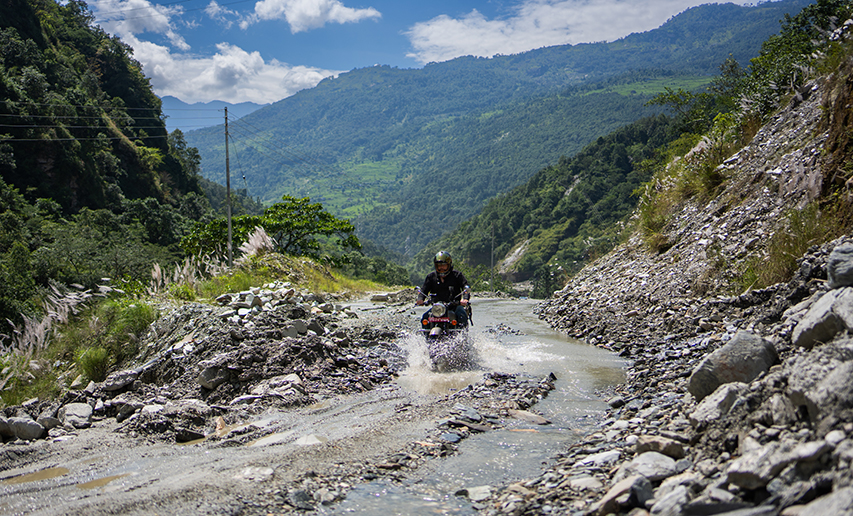
Photo: Stretch of the Beni-Jomsom Highway / BK Magazine
The goal for the next day was to make it to a quiet Himalayan town called Kalopani before making the push to Jomsom, Shinta Mani Mustang’s new home. This day would be hard.
The ride to the hot springs town of Tatopani is a dream of misty hills and waterfalls spritzing riders with spray over flat black top roads—every rider’s dream. Then you hit the Beni-Jomsom “Highway.” Ten years ago, this stretch of road didn’t even exist. The only way to get to Jomsom was to fly or to trek for nearly a week.
Even today, “road” is a bit of a haughty term for the black mud, scree, newly fallen boulders, and 45 degree rock-strewn climbs that, on an Enfield, seem to defy physics. There are hundred-meter-long stretches of good asphalt to remind you what roads feel like before you’re thrown back into shaking your hind quarters into disrepair—the Mustang massage, we call it.
 Photo: Jeep on the Beni-Jomsom Highway / BK Magazine
Photo: Jeep on the Beni-Jomsom Highway / BK Magazine
In monsoon season, this pass can be closed altogether, and earth movers struggle day and night to keep the eroding mountains from the paved and unpaved sections.
To your right is a sheer drop hundreds of meters and the angry Kali Gandaki river raging gray and white below. To your left, rocks and boulders, some as big as cars knocking out the entire road, fall from the sky.
Though treacherous and not to be underestimated, the pass can be traversed by any competent off-roader. It’s not some sort of impassable Herculean feat or a death-defying drive. As long as it doesn’t rain.
It rained.
Photo: Kali Gandaki River as the rain sets in on the Beni-Jomsom Highway / BK Magazine
The bad luck weather hit at the worst time. Roads of dry rock became running creeks of gravel as we ascended at a snail’s pace to climb after climb after climb. Exhaustion after more than ten hours of driving took its toll. Bikes were dropped. Tantrums were thrown. Slowly the sun began to set as we scrambled up the final hills.
After a whole day of banging off of rocks, one bike’s foot brake broke off. The other started leaking oil into the air filter. The decision was made to drive one bike to Kalopani just a few kilometers away before sunset. One driver was left stranded with the remaining bike in the pitch black of night, watching a slow motion landslide until a jeep could be sent for help. It took just over three hours.
Day 4: To Shinta Mani Mustang
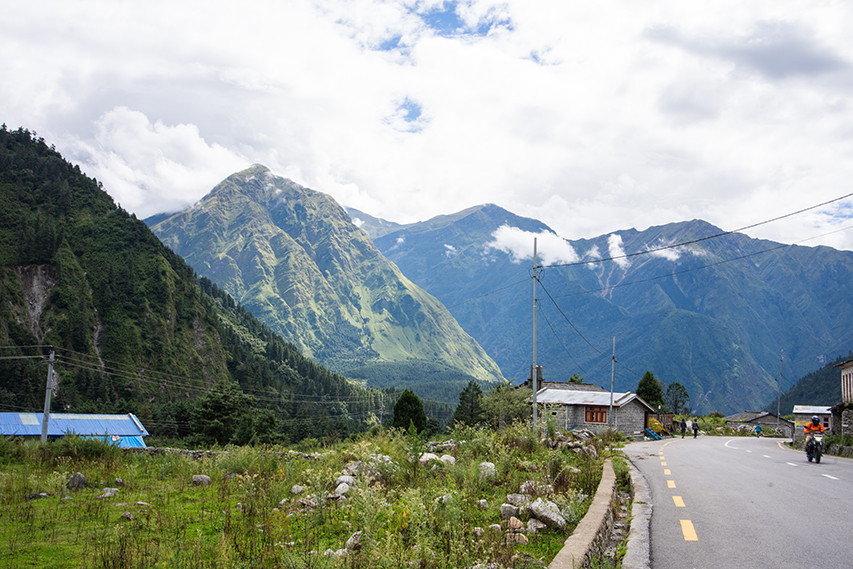 Photo: Morning in Kalopani in Mustang / BK Magazine
Photo: Morning in Kalopani in Mustang / BK Magazine We wake with Kalopani’s green hills and gray stones brushed in white fog and the good news that our bikes would be driveable. Coincidentally, it was also a holiday for Vishwakarma, the Hindu God of Machines. The faithful decorated their cars, trucks, and motorbikes with red and yellow dye and ribbons. Considering the state of our bikes, we were in no mood for any of Vishwakarma’s nonsense. What have you done for me lately, Vishwakarma?
Today would be the greatest reason to take bikes to Mustang. In one three hour drive, the highland forests turn to pine trees clinging to cliffs in vistas reminiscent of Swiss alps. Within an hour, the landscape morphs again into desiccated, stark mountains decorated in tawny stones and small patches of green clinging to life on a whole new planet.
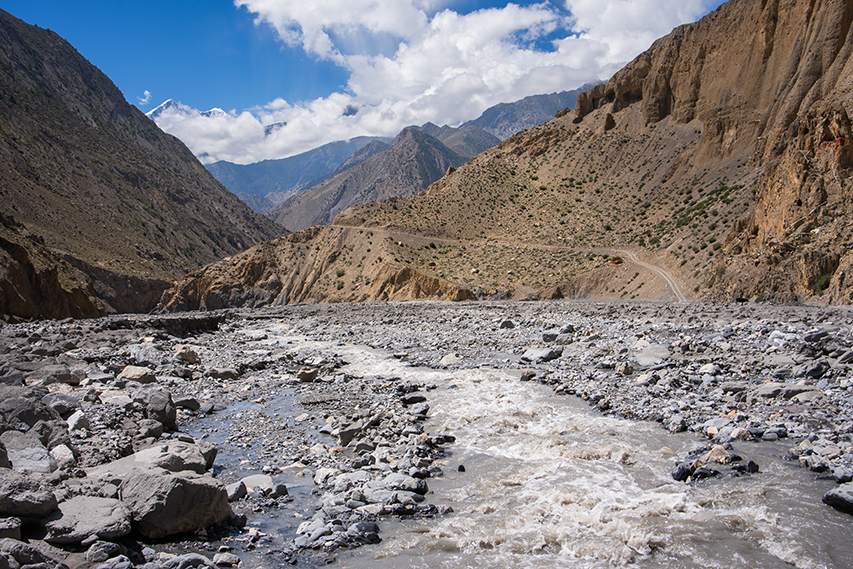 Photo: The landscape shifts to the dry, windy Jomsom area / BK Magazine
Photo: The landscape shifts to the dry, windy Jomsom area / BK Magazine
We had made it to the windy valley, to Jomsom. Bikes shaking with wear, bodies shocked from temperature change and altitude, we crossed 2,700 meters above sea level to get to our goal: Shinta Mani Mustang.
GM Pradyot Rana tells BK that around 40% of guests will arrive at this lush hotel by helicopter, the rest by plane. We arrived caked in dried mud of four different hues, chugging our bikes up the six sharp bends to the stupa and golden yak at the entrance.
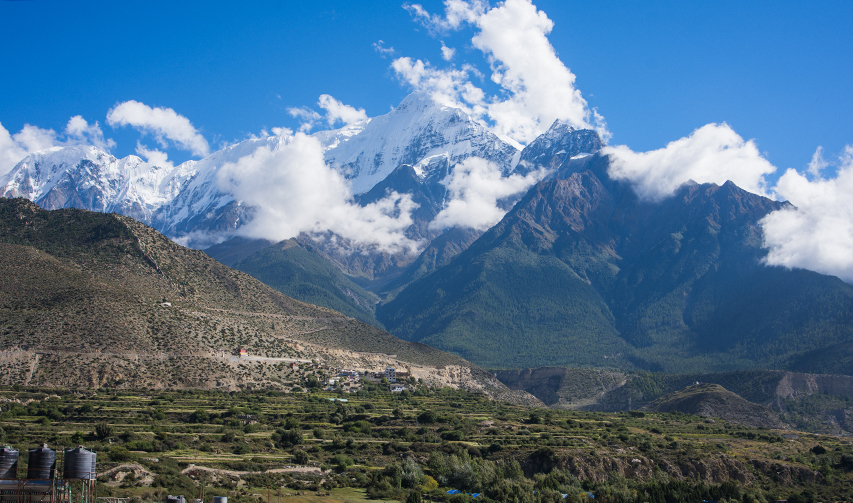 Photo: View of the Annapurna range from the window at Shinta Mani Mustang / BK Magazine
Photo: View of the Annapurna range from the window at Shinta Mani Mustang / BK Magazine
Nothing like this hotel has ever existed in Jomsom—or for that matter the whole of the Annapurna range. It’s a design-forward luxury hotel boasting perhaps the greatest view (weather permitting) in the whole of South Asia. The mountains that in Pokhara seemed to be almost on the moon are now the whole horizon, almost like you can reach out and touch them.
Some features here will be familiar to guests at Bensley’s Shinta Mani properties in Cambodia—a Bensley butler, the Tim Burton-like parallel lines, the wild throws and pillows—but this is a toned down, neutral aesthetic.
A long outdoor corridor slices down to the lobby, flanked on both sides by the 29 rooms. Inside, guests will find the only dining venue, Nilgiri, and the bar, Aara Bar. The temperature will plummet in the winter months, but the property comes equipped with a fashionable fire pit, and the mountains are still visible, even at night, from indoors.
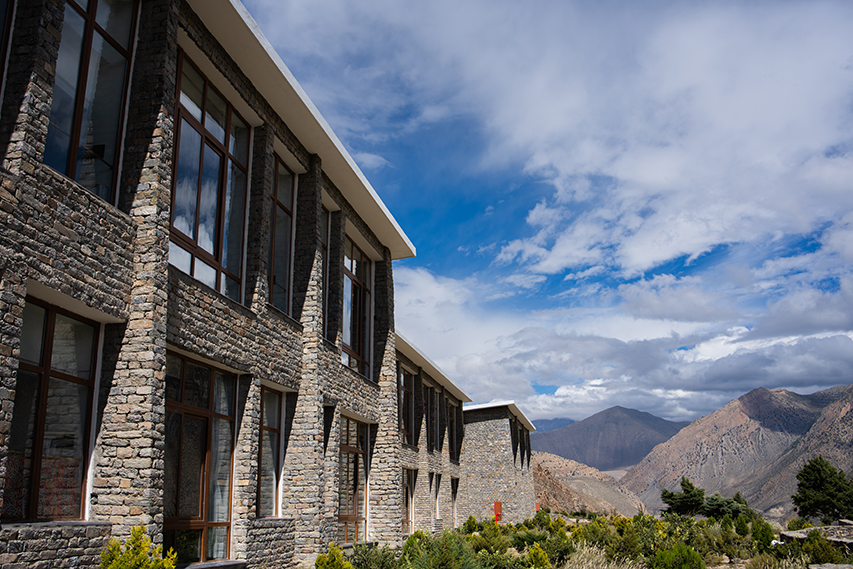 Photo: Shinta Mani Mustang exterior / BK Magazine
Photo: Shinta Mani Mustang exterior / BK Magazine
The building is made from local stone, reminiscent of the soft grays that run through the Kali Gandaki River below, and traditional touches are found in every corner: yak fur on the mini-bar, Tibetan mantras etched in stone, local logs of prosperity in the wall, and floor to ceiling windows that let the true star of the location—the Himalayas—into your room.
You wake to blue skies, apple orchards, and the mighty Annapurna peaks in a luxurious room designed to make Earth’s largest mountain range into window dressing.
The menu comes from Chef Krishna who builds a fruit-heavy tasting menu from local ingredients, including what we thought would be Hokkaido scallops that turned out to be local radishes. This is not an easy part of the world to live in. For a few months of the year, many in higher Mustang subsist on only a few dishes. With this, Shinta Mani Mustang makes a bounty.
Photo: Shinta Mani Mustang exterior at night / BK Magazine
It’s a holistic resort. Everything from wellness facilities to excursions are available here. From archery and horse riding to yoga and the famous Mustang caves, Shinta Mani Mustang.
Our journey continued to Lupra and Muktinath temple at 3,700 meters above sea level, just a few hours’ drive from the Shinta Mani Mustang. Jomsom, for trekkers or leisure travelers, has always been a jumping off point for something more. Now that’s changed. Shinta Mani Mustang is a destination unto itself.
The landscape will always be the star of Lower Mustang. But now there’s more reason to drive—and drive faster.
Photo: Avocado toast at Shinta Mani Mustang with a view of the Annapurna range / BK Magazine

